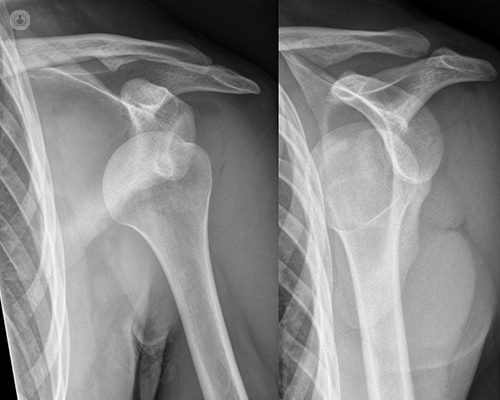

What is shoulder instability?
Shoulder instability is a problem affecting the structures surrounding the shoulder joint. The shoulder is a ‘ball-and-socket’ joint, meaning the end of the humerus (the upper arm bone) looks like a ball, fitting inside the corresponding socket in the scapula (shoulder blade). In shoulder instability, this joint is too loose, causing the joint to either slide out of place or dislocate completely in more extreme cases.

Prognosis
If the shoulder instability is treated correctly, prognosis is generally good. You may be required or advised to give up certain activities which provoke the instability. Avoidance of these activities increases the chances that the instability will not occur again.
Symptoms of shoulder instability
In those with shoulder instability, a feeling of the ball coming out of the socket, or your shoulder ‘giving way’ may be experienced. This usually causes pain in the shoulder. This pain can intensify with certain movements, such as reaching back or behind the body. Other symptoms which may occur afterwards include bruising and swelling in the area.
Medical tests to diagnose shoulder instability
The doctor will conduct a physical examination and take your medical history. They will check your range of motion and if there are any points on the shoulder which are more sensitive, or tender. An X-ray will likely be taken to either confirm the cause of shoulder instability or to rule out other causes of shoulder pain.
If necessary, the specialist will order more tests, such as an MRI scan or a CT scan, if further evaluation is required.
What are the causes of shoulder instability?
Shoulder instability generally occurs when the lining of the shoulder joint, the ligaments or the labrum (rim of cartilage reinforcing the ball-and-socket joint) are stretched or torn, or become completely detached. If this happens the ball of the shoulder joint can move out the socket, either partially or completely.
This can happen more frequently in young athletes, especially those who engage in activities which require overhead range of movement, such as volleyball, baseball, cricket, or swimming. Shoulder instability may also affect those with connective tissue disorders (e.g joint laxity, being ‘double jointed’) more frequently. Finally, joint instability may more frequently affect those who have previously experienced shoulder dislocation.
Can shoulder instability be prevented?
It can be difficult to prevent shoulder injuries, but taking certain precautions while engaging in sport can reduce the risk of injuries occurring. Warm up and cool down before exercising, and try not to perform the same, repetitive activities while engaging in sport.
Treatments for shoulder instability
After shoulder instability, rest and recuperation is vital. Resting the joint for a few days afterwards is important, avoiding any activities which would worsen the injury. Bracing or immobilisation may be necessary in certain cases to reduce the risk of the injury getting worse. When the pain and swelling have gone down, you will be advised to start exercises to improve your range of motion and strengthen the joint.
Pain and swelling can be helped by the application of hot or cold packs, and through NSAIDs (nonsteroidal anti-inflammatory drugs), e.g ibuprofen. After therapy is complete and the range of motion and joint strength are restored, you can return to normal activity.
In some cases, surgery for shoulder instability may be necessary, for example in those who cannot or do not want to modify their activity (e.g sports players). Arthroscopic techniques can be used to stabilise the shoulder.
Which type of specialist treats shoulder instability?
An orthopaedic surgeon, in particular a shoulder specialist, treats shoulder instability, particularly in cases of surgical intervention. You may also be referred to a sports medicine specialist or physiotherapist in order to fully recover activity.
